An Assessment of Ph, Toxic and Essential Chemical Elements in Water by Analytical Techniques.
DOI:
https://doi.org/10.59675/P213Keywords:
Water assessment, Toxic elements,, Essential elements, ICP-AES.Abstract
Water quality and safety assessment has become essential in water resource studies. Water is an important substance in all aspects of life. Therefore, it must have beneficial compositions and ensure sustainable purity. Water quality monitoring is essential for the protection of public health. Sediments and pollutants in water could harm the organisms in the water body. Polluted water is a complex global problem affecting human and animal health, agriculture, and industry. Water could be affected and contaminated by toxic elements. Toxic element pollution is a serious environmental problem and a hazard that can be monitored in water. Technologies were developed to assess the essential and toxic elements in water. Inductively coupled plasma atomic emission spectrophotometry (ICP-AES) has been used to analyze water and determine water quality. The results show the total concentration of all elements: 0.001-0.0042, 0.0095-0.004, 0.0066-0.0042, and 0.0923-0.078 mg/L for mercury, arsenic, cadmium, and lead, respectively. Physical and chemical properties of water samples, such as pH, salinity, TDS, EC, turbidity, and DO, were measured.
References
- Cybulski J, Witczak A, Pokorska-Niewiada K. Essential and Toxic Elements in Drinking Water: Water Treatment and Wastewater Treatment. Research Square. 2021: 1-28.
- Sivaranjani S., Rakshit A., Singh A. Water Quality Assessment with Water Quality Indices. International Journal of Bioresource Science. 2015; 2(2): 85-94.
- Abdulnabi Z A. Assessment of some toxic elements levels in Iraqi marine water. Mesopotamian Journal of Marine Sciences. 2016; 31(1): 85 – 94.
- Keil DE, PhD, DABT, Berger-Ritchie J, McMillin GA, PhD, DABCC (CC, TC).
Testing for Toxic Elements: A Focus on Arsenic, Cadmium, Lead, and Mercury LABMEDICINE. 2011; 42(12): 735-742.
- Helaluddin ABM, Khalid RS, Alaama M, Abbas SA. Main Analytical Techniques Used for Elemental Analysis in Various Matrices. Tropical Journal of Pharmaceutical Research. 2016; 15 (2): 427-434.
- Frisbie SH, Ortega R, Maynard DM, Sarkar B. The oncentrations of Arsenic and Other Toxic Elements in Bangladesh’s Drinking Water. Environmental Health Perspectives. 2022; 110(11): 1147-1153.
- Demir F, Ozen M Y, Derun E M. Determination of essential and non-essential element contents of drinking water and baby water for infant’s nutrition. Main Group Met. Chem. 2021; 44: 194–202.
- Ungureanu E L, Soare A D, Mocanu A L, Iorga, S C, Mustatea G, Popa M E. Occurrence of Potentially Toxic Elements in Bottled Drinking Water—Carcinogenic and Non-Carcinogenic Risks Assessment. Foods. 2022; 11(1407): 1-13.
- Kabriti M, Léonce EDAM, Merbouh C, abdelfattah B, achkir A. Phsical-Chemical Characterization and Heavy Metals Assessment of waters and Sediments of Sebou Watershed (TOPSEBOU, MOROCCO). Karbala International Journal of Modern Science. 2021; 7(10): 16-29.
- Nayak A, Matta G, Uniyal D P, Kumar A, Kumar P, Pant G. Assessment of potentially toxic elements in groundwater through interpolation, pollution indices, and hemometric techniques in Dehradun in Uttarakhand State. Environmental Science and Pollution Research. 2023.
- Belle G, Schoeman Y, Oberholster P. Potential Toxic-Element Pollution in Surface Water and Its Implications for Aquatic and Human Health:Source–Pathway–Receptor Model. Water. 2023; 15(3100): 1-22.
- Milačič R, Zuliani T, Vidmar J, Bergant M, Kalogianni E, Smeti E, Skoulikidis N, Ščančar J. Potentially toxic elements in water, sediments and fish of the Evrotas
River under variable water discharges. Science of the Total Environment. 2019; 648: 1087–1096.
- Khan SA, Abeer N, Hussain SZ, Muhammad S, Jawad F, Khan T. Potentially toxic elements contamination in water and evaluation for risk assessment in the Rawalpindi, Pakistan. Desalination and Water Treatment. 2019; 159: 327–337.
- Alqahtani FZ, DaifAllah SY, Alaryan YF, Elkhaleefa AM, Brima EI. Assessment of Major and Trace Elements in Drinking Groundwater in Bisha Area, Saudi Arabia. Journal of Chemistry. 2020: 1-10.
- Srivastava A, Chahar V, Sharma V, Swain KK, Hoyler F, Murthy GS, Scherer UW, Rupp H, Knolle F, Maekawa M, Schnug E. Study of Toxic Elements in River Water and Wetland Using Water Hyacinth (Eichhornia crassipes) as Pollution Monitor. Global Challenges. 2019; 3: 1-6.
- Al-saad H, Khwedim K, Al-khalf NA. Geochemical Assessment of Some Trace Elements in Selected Locations at Thi-Qar Governorate Soil, Southeast Iraq. Iraqi Journal of Science. 2023:6368-82.
- Al-Fatlawi HJ, Jabar RAA, AL-Gumer BM. The Study of some trace elements and some related environmental factors of groundwater in Karbala province, Iraq. Journal of Pharmaceutical Sciences and Research. 2018;10(12):3207.
- Dinelli E, Lima A, Albanese S, Birke M, Cicchella D, Giaccio L, et al. Major and trace elements in tap water from Italy. Journal of Geochemical Exploration. 2012;112:54-75.
- Hooda PS, Trace element in soil School of Geography, Geology and the Environment, Kingston University London, UK. A John Wiley and Sons Ltd. 2010; Vol(7):page numbers (4051-6037).
- Gaillardet J, Viers J, Dupré B. Trace elements in river waters. Treatise on geochemistry. 2003;5:605.
- Tanase IG, Popa DE, Udriştioiu GE, Bunaciu AA, Aboul‐Enein HY. Validation and Quality Control of an ICP‐MS Method for the Quantification and Discrimination of Trace Metals and Application in Paper Analysis: An Overview. Critical reviews in analytical chemistry. 2014;44(4):311-27.
- Carrillo‐González R, Šimůnek J, Sauvé S, Adriano D. Mechanisms and pathways of trace element mobility in soils. Advances in agronomy. 2006;91:111-78.
- Cannas D, Loi E, Serra M, Firinu D, Valera P, Zavattari P. Relevance of essential trace elements in nutrition and drinking water for human health and autoimmune disease risk. Nutrients. 2020;12(7):2074.
- Natasha N, Shahid M, Khalid S, Bibi I, Naeem MA, Niazi NK, et al. Influence of biochar on trace element uptake, toxicity and detoxification in plants and associated health risks: A critical review. Critical Reviews in Environmental Science and Technology. 2022;52(16):2803-43.
Downloads
Published
Issue
Section
License
Copyright (c) 2024 Academic International Journal of Pure Science

This work is licensed under a Creative Commons Attribution 4.0 International License.





